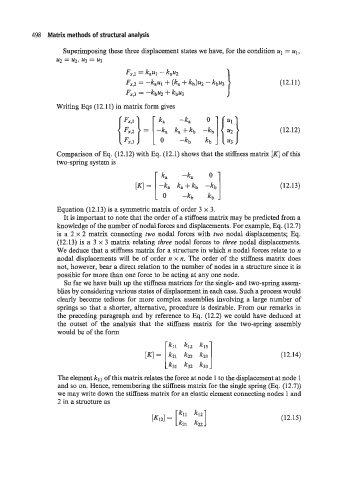Page 517 - Aircraft Stuctures for Engineering Student
P. 517
498 Matrix methods of structural analysis
Superimposing these three displacement states we have, for the condition u1 = ul,
u2 = 242, u3 = u3
Fx,1 = kau1 - kau2
Fx,2 = -kul -k (ka -k kb)u2 - kbu3 1 (12.11)
Fx,3 = -kbU2 -k kbU3
{ ::} = [ -: 4.1 { ::} (12.12)
Writing Eqs (12.11) in matrix form gives
ka
-ka
k:-:
Comparison of Eq. (12.12) with Eq. (12.1) shows that the stiffness matrix [Kl of this
two-spring system is
[ 0 4.1
ka
-ka
[q = -k, ka+kb (12.13)
-kb
Equation (12.13) is a symmetric matrix of order 3 x 3.
It is important to note that the order of a stiffness matrix may be predicted from a
knowledge of the number of nodal forces and displacements. For example, Eq. (12.7)
is a 2 x 2 matrix connecting two nodal forces with two nodal displacements; Eq.
(12.13) is a 3 x 3 matrix relating three nodal forces to three nodal displacements.
We deduce that a stiffness matrix for a structure in which n nodal forces relate to n
nodal displacements will be of order n x n. The order of the stiffness matrix does
not, however, bear a direct relation to the number of nodes in a structure since it is
possible for more than one force to be acting at any one node.
So far we have built up the stiffness matrices for the single- and two-spring assem-
blies by considering various states of displacement in each case. Such a process would
clearly become tedious for more complex assemblies involving a large number of
springs so that a shorter, alternative, procedure is desirable. From our remarks in
the preceding paragraph and by reference to Eq. (12.2) we could have deduced at
the outset of the analysis that the stiffness matrix for the two-spring assembly
would be of the form
kll kl2 k13
[lul = k21 k22 (12.14)
[ k31 k32
The element kl of this matrix relates the force at node 1 I the displacemen at node 1
and so on. Hence, remembering the stiffness matrix for the single spring (Eq. (12.7))
we may write down the stiffness matrix for an elastic element connecting nodes 1 and
2 in a structure as
kll kl2 (12.15)
[K121 = [ k21 k22]

